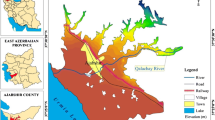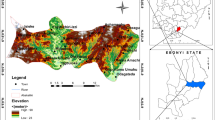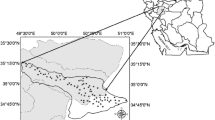Abstract
For coastal areas, groundwater aquifers’ salinization has intensified due to multiple reasons, e.g., climate changes, continuous groundwater exploitation, and other anthropogenic activities. In Ba Ria–Vung Tau province, the Pleistocene aquifer is an essential source of water supply for drinking, agriculture, and industrial purposes. Thus, a groundwater vulnerability assessment was required. The objective of the study is to estimate groundwater vulnerability against salinization by applying the modified DRASTIC models with geographic information system (GIS). The modified DRASTIC models, which combine the original DRASTIC model with anthropogenic factor (land use). In addition to that, Entropy method (EN) was used to reassign the factor weights of the original DRASTIC model to improve the consistency of the conventional model with the actual conditions of the study area. The total dissolved solid (TDS) data collected from 31 monitoring boreholes was applied to validate the groundwater vulnerability assessments. The results show that around 0.97%, 84.94%, and 14.09% of areas fall under low-, moderate-, and high-vulnerable zones, respectively. They also confirm the seaward-increasing tendency of vulnerability. The study demonstrates that optimizing a conventional DRASTIC model through Entropy weight modification and integrating the land use layer in the original DRASTIC (DRASTIC-EN-LU) model had the best performance. Among the intrinsic factors, D, I, and LU are the most sensitive parameters in the study area. The accurate assessment of groundwater vulnerability is necessary for control and prevention in the province of Ba Ria–Vung Tau. Findings of this study can help authorities of Ba Ria–Vung Tau province in groundwater protection and decision-making with regards to salinization.









Similar content being viewed by others
Data availability
The data used to support the findings of this study are available from the corresponding author upon request.
Abbreviations
- D:
-
Depth to water table
- R:
-
Net recharge to the aquifer
- A:
-
Aquifer media
- S:
-
Soil media
- T:
-
Topography
- I:
-
Impact of vadose zone
- C:
-
Hydraulic conductivity
- LU:
-
Land use/land cover
- DONRE:
-
Department of Natural Resources and Environment
- DARD:
-
Department of Agriculture and Rural Development
References
Adimalla N (2021) Application of the Entropy Weighted Water Quality Index (EWQI) and the Pollution Index of Groundwater (PIG) to assess groundwater quality for drinking purposes: a case study in a rural area of Telangana State, India. Arch Environ Contam Toxicol 80(1):31–40. https://doi.org/10.1007/s00244-020-00800-4
Agency HEM (2018) National technical regulation on Domestic Water Quality. M. o. S. Technology. Ministry of Health, Ha Noi
Aller L, Bennett T, Lehr JH, Petty RJ (1985) DRASTIC: a standardized system for evaluating ground water pollution potential using hydrogeologic settings. U.S. Environmental Protection Agency, Wasington, DC. EPA/600/2-85-018
Au NH (2022) Application of a GIS-based DRASTIC model for aquifer vulnerability assessment in the Coastal Southeastern region, Vietnam. Vietnam National University Ho Chi Minh City (VNU-HCM) under grant number 562-2022-24-01
Barzegar R, Moghaddam AA, Baghban H (2015) A supervised committee machine artificial intelligent for improving DRASTIC method to assess groundwater contamination risk: a case study from Tabriz plain aquifer, Iran. Stoch Environ Res Risk Assess 30(3):883–899. https://doi.org/10.1007/s00477-015-1088-3
Boumaiza L, Walter J, Chesnaux R, Brindha K, Elango L, Rouleau A, Wachniew P, Stumpp C (2021) An operational methodology for determining relevant DRASTIC factors and their relative weights in the assessment of aquifer vulnerability to contamination. Environ Earth Sci 80:1–19. https://doi.org/10.1007/s12665-021-09575-w
Brindha K, Elango L (2015) Cross comparison of five popular groundwater pollution vulnerability index approaches. J Hydrol 524:597–613. https://doi.org/10.1016/j.jhydrol.2015.03.003
Chakraborty B, Roy S, Bera A, Adhikary PP, Bera B, Sengupta D, Bhunia GS, Shit PK (2021) Groundwater vulnerability assessment using GIS-based DRASTIC model in the upper catchment of Dwarakeshwar river basin, West Bengal, India. Environ Earth Sci. https://doi.org/10.1007/s12665-021-10002-3
Department of Natural Resources and Environment of Ba Ria-Vung Tau Province (2011) Research and construction of groundwater monitoring network in Ba Ria-Vung Tau province. Ba Ria-Vung Tau Province
Department of Natural Resources and Environment of Ba Ria-Vung Tau Province (2020) Investigation and assessment of salinity in aquifers due to the impacts of climate change, sea level rise in coastal areas of Ba Ria-Vung Tau province Department of Natural Resources and Environment of Ba Ria-Vung Tau Province, Ba Ria, Vietnam
Department of Natural Resources and Environment of Ba Ria-Vung Tau Province (2021) Operation of groundwater monitoring network in Ba Ria-Vung Tau Province. Department of Natural Resources and Environment of Ba Ria-Vung Tau Province, Ba Ria, Vietnam
Department of Natural Resources and Environment of Ba Ria-Vung Tau Province (2022) Construction of sea surface usage plan in Ba Ria-Vung Tau Province Department of Natural Resources and Environment of Ba Ria-Vung Tau Province, Ba Ria, Vietnam
Elubid BA, Huag T, Ahmed EH, Zhao J, Elhag KM, Abbass W, Babiker MM (2019) Geospatial distributions of groundwater quality in Gedaref State using geographic information system (GIS) and drinking water quality index (DWQI). Int J Environ Res Public Health. https://doi.org/10.3390/ijerph16050731
General Statistic Office (2021) gso.gov.vn
Ghazavi R, Ebrahimi Z (2015) Assessing groundwater vulnerability to contamination in an arid environment using DRASTIC and GOD models. Int J Environ Sci Technol 12(9):2909–2918. https://doi.org/10.1007/s13762-015-0813-2
Ghosh A, Tiwari AK, Das S (2015) A GIS based DRASTIC model for assessing groundwater vulnerability of Katri Watershed, Dhanbad, India. Model Earth Syst Environ. https://doi.org/10.1007/s40808-015-0009-2
Goyal D, Haritash AK, Singh SK (2021) A comprehensive review of groundwater vulnerability assessment using index-based, modelling, and coupling methods. J Environ Manag 296:113161
Guo X, Xiong H, Li H, Gui X, Hu X, Li Y et al (2023a) Designing dynamic groundwater management strategies through a composite groundwater vulnerability model: Integrating human-related parameters into the DRASTIC model using LightGBM regression and SHAP analysis. Environ Res 236:116871
Guo X, Yang Z, Li C, Xiong H, Ma C (2023b) Combining the classic vulnerability index and affinity propagation clustering algorithm to assess the intrinsic aquifer vulnerability of coastal aquifers on an integrated scale. Environ Res 217:114877
Gupta T, Kumari R (2023) Assessment of groundwater nitrate vulnerability using DRASTIC and modified DRASTIC in upper catchment of Sabarmati basin. Environ Earth Sci 82(9):1–17. https://doi.org/10.1007/s12665-023-10880-9
Hasan I, Reza S, Siddique AB, Akbor A, Hasan M, Nahar A, Islam I (2023) Assessment of groundwater vulnerability for seawater intrusion using DRASTIC model in coastal area at Patuakhali District, Bangladesh. Environ Sci Pollut Res 30(1):1–20
Heiß L, Bouchaou L, Tadoumant S, Reichert B (2020) Index-based groundwater vulnerability and water quality assessment in the arid region of Tata city (Morocco). Groundw Sustain Dev. https://doi.org/10.1016/j.gsd.2020.100344
IPCS-Investment Promotion Center-South, Vietnam (2019) Local Information. https://ipcs.mpi.gov.vn/ba-ria-vung-tau/. Accessed 25 May 2023
Jha R, Singh VP, Vatsa V (2008) Analysis of urban development of Haridwar, India, using entropy approach. KSCE J Civ Eng 12(4):281–288. https://doi.org/10.1007/s12205-008-0281-z
Kardan Moghaddam H, Jafari F, Javadi S (2017) Vulnerability evaluation of a coastal aquifer via GALDIT model and comparison with DRASTIC index using quality parameters. Hydrol Sci J 62(1):137–146
Kazakis N, Voudouris KS (2015) Groundwater vulnerability and pollution risk assessment of porous aquifers to nitrate: modifying the DRASTIC method using quantitative parameters. J Hydrol 525:13–25. https://doi.org/10.1016/j.jhydrol.2015.03.035
Kozłowski M, Sojka M (2019) Applying a modified DRASTIC model to assess groundwater vulnerability to pollution: a case study in Central Poland. Pol J Environ Stud 28(3):1223–1231. https://doi.org/10.15244/pjoes/84772
Le TN, Tran DX, Tran TV, Gyeltshen S, Lam TV, Luu TH, Nguyen DQ, Dao TV (2021) Estimating soil water susceptibility to salinization in the Mekong River Delta using a modified DRASTIC model. Water. https://doi.org/10.3390/w13121636
Mfumu Kihumba A, Vanclooster M, Ndembo Longo J (2017) Assessing groundwater vulnerability in the Kinshasa region, DR Congo, using a calibrated DRASTIC model. J Afr Earth Sci 126:13–22. https://doi.org/10.1016/j.jafrearsci.2016.11.025
Momejian N, Abou Najm M, Alameddine I, El-Fadel M (2019) Can groundwater vulnerability models assess seawater intrusion? Environ Impact Assess Rev 75:13–26
Mondal NC (2019) Estimation of vulnerability of groundwater in a granitic aquifer to pollution using entropy theory. Curr Sci 116(9):1555–1559. https://www.jstor.org/stable/27138075
Mondal NC, Ahmed S (2015) Landscape entropy approach to demarcate pathways for oozing of water in a desert area in India. Curr Sci India 109(1):148–157
Mondal NC, Singh VP (2012) Evaluation of groundwater monitoring network of Kodaganar River basin from Southern India using entropy. Environ Earth Sci 66:1183–1193. https://doi.org/10.1007/s12665-011-1326-z
Mondal NC, Adike S, Ahmed S (2018) Development of entropy-based model for pollution risk assessment of hydrogeological system. Arab J Geosci. https://doi.org/10.1007/s12517-018-3721-1
Nguyen AH, Pham KQ, Le QH (2023) Assessment of Pleistocene aquifer vulnerability to saline intrusion in the coastal region of Ba Ria-Vung Tau province using GIS and entropy-GALDIT. Sustainability. https://doi.org/10.3390/su15108107
Noori R, Ghahremanzadeh H, Klove B, Adamowski JF, Baghvand A (2019) Modified-DRASTIC, modified-SINTACS and SI methods for groundwater vulnerability assessment in the southern Tehran aquifer. J Environ Sci Health A Tox Hazard Subst Environ Eng 54(1):89–100. https://doi.org/10.1080/10934529.2018.1537728
NRC (National Research Council) (1993) Ground water vulnerability assessment: contamination potential under conditions of uncertainty. National Academy Press, Washington, DC
Patrikai O, Kazakis N, Voudouris K (2012) Vulnerability map: a useful tool for groundwater protection: an example from Mouriki basin, north Greece. Fresenius Environ Bull 21(8c):2516–2521
Paul S, Das CS (2021) An investigation of groundwater vulnerability in the North 24 parganas district using DRASTIC and hybrid-DRASTIC models: a case study. Environ Adv. https://doi.org/10.1016/j.envadv.2021.100093
Rajput H, Goyal R, Brighu U (2020) Modification and optimization of DRASTIC model for groundwater vulnerability and contamination risk assessment for Bhiwadi region of Rajasthan, India. Environ Earth Sci. https://doi.org/10.1007/s12665-020-8874-z
Sener E, Davraz A (2012) Assessment of groundwater vulnerability based on a modified DRASTIC model, GIS and an analytic hierarchy process (AHP) method: the case of Egirdir Lake basin (Isparta, Turkey). Hydrogeol J 21(3):701–714. https://doi.org/10.1007/s10040-012-0947-y
Shakeri R, Alijani F, Nassery HR (2023) Comparison of the DRASTIC + L and modified VABHAT models invulnerability assessment of Karaj aquifer, central Iran, using MCDM, SWARA, and BWM methods. Environ Earth Sci 82(4):82–97. https://doi.org/10.1007/s12665-023-10773-x
Shirazi SM, Imran HM, Akib S, Yusop Z, Harun ZB (2013) Groundwater vulnerability assessment in the Melaka State of Malaysia using DRASTIC and GIS techniques. Environ Earth Sci 70(5):2293–2304. https://doi.org/10.1007/s12665-013-2360-9
Singh VP (1998) The use of entropy in hydrology and water resources. Hydrol Process 11:587–626
Singh A, Srivastav SK, Kumar S, Chakrapani GJ (2015) A modified-DRASTIC model (DRASTICA) for assessment of groundwater vulnerability to pollution in an urbanized environment in Lucknow, India. Environ Earth Sci 74(7):5475–5490. https://doi.org/10.1007/s12665-015-4558-5
Taghavi N, Niven RK, Paull DJ, Kramer M (2022) Groundwater vulnerability assessment: a review including new statistical and hybrid methods. Sci Total Environ 822:153486
Vietnam Investment Review (2022) Ba Ria-Vung Tau province hitting targets in style. Ministry of Planning and Investment. https://vir.com.vn/ba-ria-vung-tau-province-hitting-targets-in-style-98872.html. Accessed May 2023
Voutchkova DD, Schullehner J, Rasmussen P, Hansen B (2021) A high-resolution nitrate vulnerability assessment of sandy aquifers (DRASTIC-N). J Environ Manag 277:111330. https://doi.org/10.1016/j.jenvman.2020.111330
Wang B, Teng Y, Wang H, Zuo R, Zhai Y, Yue W, Yang J (2020) Entropy weight method coupled with an improved DRASTIC model to evaluate the special vulnerability of groundwater in Songnen Plain, Northeastern China. Hydrol Res 51(5):1184–1200. https://doi.org/10.2166/nh.2020.056
Wei W, Wenxu W, Lin Z, Rui C, Lishan M, Sheming C, Futian L (2021) Application of DRASTIC entropy weight model method in groundwater vulnerability evaluation in Ordos area. IOP Conf Ser: Earth Environ Sci. https://doi.org/10.1088/1755-1315/702/1/012058
Yang YS, Wang L (2010) Catchment-scale vulnerability assessment of groundwater pollution from diffuse sources using the DRASTIC method: a case study. Hydrol Sci J 55(7):1206–1216. https://doi.org/10.1080/02626667.2010.508872
Zghibi A, Merzougui A, Chenini I, Ergaieg K, Zouhri L, Tarhouni J (2016) Groundwater vulnerability analysis of Tunisian coastal aquifer: an application of DRASTIC index method in GIS environment. Groundw Sustain Dev 2:169–181
Funding
This study was funded by Vietnam National University Ho Chi Minh City (VNU-HCM) (Grant no. 562-2022-24-01).
Author information
Authors and Affiliations
Contributions
NHA—conceptualization, methodology, investigation, visualization, writing of the original draft and supervision. THMV—methodology, conceptualization, investigation, and project administration. HTTT—conceptualization, writing—review, and editing.
Corresponding author
Ethics declarations
Conflict of interest
The authors declare that they have no conflicts of interest.
Additional information
Publisher's Note
Springer Nature remains neutral with regard to jurisdictional claims in published maps and institutional affiliations.
Rights and permissions
Springer Nature or its licensor (e.g. a society or other partner) holds exclusive rights to this article under a publishing agreement with the author(s) or other rightsholder(s); author self-archiving of the accepted manuscript version of this article is solely governed by the terms of such publishing agreement and applicable law.
About this article
Cite this article
Nguyen, A.H., Hong Tat, V.M. & Hoang, T.T.T. Assessing groundwater vulnerability and addressing salinization in the coastal region of Ba Ria–Vung Tau province, Vietnam: an enhanced DRASTIC model approach. Environ Earth Sci 83, 53 (2024). https://doi.org/10.1007/s12665-023-11343-x
Received:
Accepted:
Published:
DOI: https://doi.org/10.1007/s12665-023-11343-x




